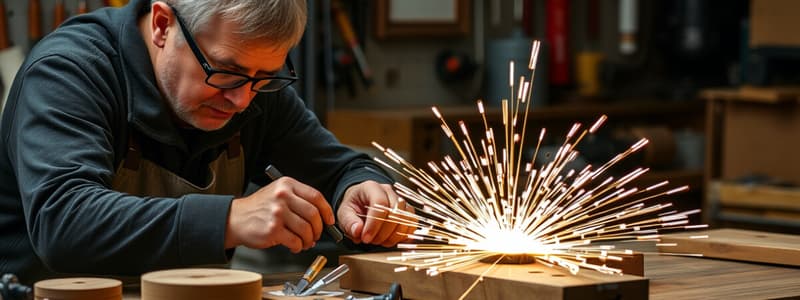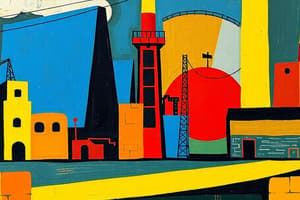Podcast
Questions and Answers
What is the primary focus of industrial arts education?
What is the primary focus of industrial arts education?
- Developing scientific theories about technology.
- Enhancing manual skills and familiarity with tools and machines. (correct)
- Teaching programming languages for technology applications.
- Fabrication of objects using traditional hand tools only.
Which organization was originally founded in 1939 and is now known as ITEEA?
Which organization was originally founded in 1939 and is now known as ITEEA?
- Global Network of Engineering Educators.
- American Industrial Arts Association. (correct)
- National Society of Technology Innovators.
- International Association of Technology Educators.
What societal factors does the purpose of industrial arts incorporate?
What societal factors does the purpose of industrial arts incorporate?
- Only provides career advancement for graduates.
- Concentrates on theoretical understanding of engineering.
- Focuses exclusively on artistic design without practical application.
- Integrates technology with personal career development. (correct)
What was a significant demand for industrial artists during the 1940s?
What was a significant demand for industrial artists during the 1940s?
What does technology education primarily focus on?
What does technology education primarily focus on?
What aspect of planning is highlighted as crucial for achieving a successful task in industrial arts?
What aspect of planning is highlighted as crucial for achieving a successful task in industrial arts?
Which factor is essential to ensure safety while conducting industrial arts tasks?
Which factor is essential to ensure safety while conducting industrial arts tasks?
Why is waste disposal emphasized in the preparation for automotive tasks?
Why is waste disposal emphasized in the preparation for automotive tasks?
What role do national competency assessments play in industrial arts careers?
What role do national competency assessments play in industrial arts careers?
How does careful preparation contribute to success in industrial arts?
How does careful preparation contribute to success in industrial arts?
Study Notes
Introduction to Industrial Arts
- An educational program focusing on the fabrication of objects in wood or metal using hand, power, or machine tools.
- Aimed at developing manual skills and familiarity with various tools and machines; commonly referred to as Technology Education.
- Technology Education involves learning about processes and knowledge related to technology.
Areas of Focus in Industrial Arts
- Includes subjects such as Automotive, Carpentry, Construction Painting, Refrigeration and Air-conditioning, Electrical Installation, Motorcycle/Small Engine Servicing, Electronic Assembly, and Plumbing.
Historical Background
- The American Industrial Arts Association (AIAA) was established in 1939, now known as the International Technology & Engineering Educators Association (ITEEA).
- ITEEA is dedicated to enhancing technology education and engineering at the K-12 levels, representing over 35,000 technology educators in more than 45 countries.
Purpose and Impact
- Industrial arts aim to integrate societal factors like technology with personal career development.
- Graduates contribute to societal advancement through manufacturing and design, implementing advanced safety techniques and efficient manufacturing methods.
- Example: Industrial arts students may focus on reducing waste through innovative design in product packaging.
Demand for Skills
- Demand for trained individuals in industrial arts evolves with corporate needs; historical examples include the need for radio design skills during World War II.
- Talented designers create competitive advantages for companies by providing innovative and technologically advanced products.
Benefits of Industrial Arts
- Offers career opportunities to students averse to traditional math and science, enabling them to gain technical skills in trades like mechanics.
- Those proficient in math and science can leverage this knowledge for product design or teaching industrial arts subjects.
National Competency Assessment
- Refers to the TESDA document certifying individuals who have proven competence in all units of competency for national qualifications in the Philippines.
- Aligns National Competencies (NCs) with specific levels in the Philippine Qualifications Framework.
Automotive Program Overview
- Includes vehicle maintenance and repair tasks like oil changes, tire rotations, and engine tune-ups.
Planning and Preparation for Tasks
- Successful outcomes rely heavily on diligent planning and preparation, fostering confidence and readiness.
Factors for Successful Task Execution
- Place: Ensure a conducive, well-ventilated, clean environment with adequate lighting for work.
- Materials: Availability of necessary tools, equipment, and materials such as specifications for tasks is essential.
- Waste Disposal: Proper disposal of used parts and substances is crucial for environmental health and safety.
- Tools/Equipment: Choose suitable, well-maintained tools to match the specific task, preventing damage to components.
- Safety: Regularly assess and prioritize safety measures to mitigate hazards during tasks.
Studying That Suits You
Use AI to generate personalized quizzes and flashcards to suit your learning preferences.
Description
This quiz covers the fundamentals of industrial arts, focusing on the fabrication of objects using wood and metal. It encompasses the educational framework of technology education, emphasizing manual skills and tool familiarity. Ideal for students in elementary and secondary education.




